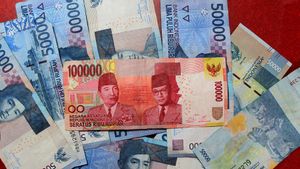JAKARTA - The entry of COVID-19 into Indonesia has made financial markets volatile. The rupiah exchange rate weakened and the Jakarta Composite Index (IHSG) dropped sharply. Industrial sectors were also disrupted.
Bank Indonesia (BI) will immediately announce five policies to counteract the impact of the COVID-19 virus on the economy. The central bank's steps include increasing intervention in the financial market with a triple intervention in the spot market, government securities, and domestic non-delivery forward or DNDF.
The outbreak of COVID-19 also has an impact on the Indonesian economy, especially the export-import trade. The Directorate General of Customs and Excise at the Ministry of Finance noted that Indonesia's foreign exchange imports to China dropped drastically by half.
Director of International and Interagency Customs at the Directorate General of Customs and Excise, Syarif Hidayat, said the foreign exchange value of imports from China in the last week of February was only US $ 463 million, down 51 percent or down by around US $ 485 million compared to the last week of January reaching US $ 948 million. .
The types of imported goods affected were computers, machinery, semi-manufactures, textiles and smartphones, which recorded a sharp decline. Not only that, the Coordinating Minister for the Economy Airlangga Hartarto said that the COVID-19 outbreak had cut the supply chains of raw materials for world industries by 30 percent. So far, the industrial raw material chain has relied on China.
"This is the first time it has been disrupted because the supply chain from China contributes 30 percent globally," said Airlangga.
DBS Group Research also revealed the domino effect of the spread of COVID-19, especially in terms of supply chains in the region. The ones most affected by this outbreak are electronic supply chains. In addition, the situation in South Korea is increasingly worrisome as a result of COVID-19 which has the potential to put pressure on this supply chain.
In China, the area most affected by COVID-19 is the region where electronics companies are producing. Starting from the coastal area, Guangdong Province where there are many smartphone factories, especially Huawei in Shenzhen City and Dongguan. The Chinese government has taken decisive steps by extending holidays and closing factories across the country.
A number of factories in China started operating in mid-February 2020. However, this is still limited due to the increasing restrictions on travel from and out of China globally.
This makes it difficult for workers who are on vacation outside the city or abroad to return to work. A number of reports say, Chinese electronics companies operating far below normal capacity, which is around 30-50 percent.
In South Korea, the COVID-19 outbreak has had the most impact in the Daegu area and its surroundings in Gyeongbuk Province. Gyeongbuk is a manufacturing center for smartphones, TVs and other electronic products, such as Samsung and LG.
However, unlike China, the South Korean government has not issued policies for companies to temporarily close factories or isolate cities where the virus is spreading.
"In fact, on a voluntary basis, LG and Samsung with smartphone production for 2-3 days at the end of February," said DBS Research Group analysts in a statement received by VOI, Wednesday, March 11.
DBS Research Group analysts see that there is still a lot of uncertainty in South Korea given there are fears the outbreak will spread nationwide in the coming months. If that happens, this can trigger tightened mobility so that the virus does not spread, which means that it will cause more serious disruption to production activities.
China is the world's largest producer of cell phones, computers and essential electronic products today. Chinese companies play an important role in the global supply of mid to low-end electronic components.
In the Asian region, South Korea and Taiwan rely most heavily on China for downstream electronics assembly. As much as 70 percent of semi-finished goods exports in the electronics sector are destined for the Chinese market.
On the other hand, most Asian countries rely heavily on China for the upstream supply of electronic components and components. Apart from South Korea and Taiwan, India, Indonesia, Thailand and Vietnam also supply 40-60 percent of semi-finished goods imports in the electronics sector from Chinese suppliers.
Meanwhile, South Korea is the most important producer of memory chips and display panels in the world. The country holds a 70 percent share in the global DRAM market and 45 percent in the NAND Flash market.
In this region, China and Vietnam rely most heavily on South Korea to supply parts and components. Statistics show that nearly 30 percent of China's imports of intermediate goods in the electronics sector come from South Korea, while 24 percent of Vietnam's needs come from South Korea.
Until now, although a number of sufferers who have been exposed to the COVID-19 virus have gradually recovered, Chinese electronics companies are still struggling to return to normal production.
Companies that depend on Chinese supplies will still feel the domino effect of this outbreak for the next 1-2 months. However, with conditions in South Korea not yet improving, China's electronic production recovery will be delayed.
However, DBS Research Group analysts emphasize the supply chain effect, especially electronics, is expected to be temporary. The sector is expected to recover by the end of 2020.
The COVID-19 virus outbreak has tested positive in Indonesia and has killed more than 3,000 people with a total of 88,000 cases of infection worldwide. The number of new cases of the COVID-19 virus in China is starting to decline, but is increasing in other countries and regions.
The English, Chinese, Japanese, Arabic, and French versions are automatically generated by the AI. So there may still be inaccuracies in translating, please always see Indonesian as our main language. (system supported by DigitalSiber.id)








